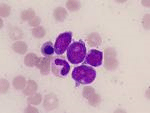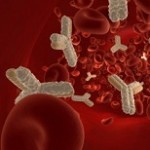Herbalzym is an alternative medical organization dedicated to developing treatment protocols for a diversity of diseases using natural medicine. For over 10 years, Herbalzym formula had been used with great success on so many terminally ill patients. It had been proven over and over again to be effective in clinical trials.
Cancer immunotherapy is the use of the immune system to reject cancer. Gammadelta (γδ) T cells are an immune cell found within epithelial tissues. Epithelial tissue is found throughout the body. It is present in the skin, as well as the covering and lining of organs and internal passageways, such as the gastrointestinal tract. Epithelial tissues are also a prominent component of glands, such as prostate gland. γδ T cells play unique and critical roles in recognition of damage or disease in epithelial tissues and provide a crucial first line of defense.
 Unlike the alphabeta (αβ) T cells of the immune system (that are launched on a search-and-destroy mission when the skin suffers a cut or other damage), most γδ T …
Unlike the alphabeta (αβ) T cells of the immune system (that are launched on a search-and-destroy mission when the skin suffers a cut or other damage), most γδ T …
Adipose tissue (fat tissue) is currently recognized as an endocrine organ similar to thyroid and pancreas, due to their ability to secrete hormones such as leptin and estrogen and estrogen that could affect metabolism, inflammation and cancer progression. We now know that tumor growth is regulated by interactions between tumor and their tissue microenvironment, such as fibroblasts, immune cells and the extracellular matrix.
Adipose tissue secretes a variety of cytokines, referred to as adipokines. Most adipokines, such as tumor necrosis factor-α (TNF-α), interleukin-6 (IL-6) and leptin, are pro-inflammatory. One prominent exception is adiponectin, an anti-inflammatory and anti-cancer adipokine, which promotes insulin sensitization and protects cardiovascular tissue from ischemic injury. Pro-inflammatory adipokines can increase chronic low-grade inflammation in adipose tissue. Tumor-associated adipocytes (fat cells) also contribute to inflammation. Inflamed tumor-associated adipose tissue …
Post-translational modifications such as phosphorylation, methylation, ubiquitination, and acetylation are crucial regulatory modules at the heart of biological processes in the cell and are tightly regulated by a multitude of enzymes. Histones are the chief protein components of chromatin, acting as spools around which DNA winds. The balance of histone acetylation and deacetylation is a critical role in the regulation of gene expression. Histone acetylation induced by histone acetyl transferases (HATs) is associated with gene transcription, while histone hypoacetylation induced by histone deacetylase (HDAC) activity is associated with gene silencing. Unlike acetylation, histone lysine methylation can signal either activation or repression, depending on the site and degree (mono-, di-, or tri-) of methylation.
HDACs also regulate the acetylation status of a variety of other non-histone substrates, including key tumor suppressor proteins …
GSK-3 (glycogen synthase kinase) is a multifunctional serine/threonine kinase that is active all the time in all cells, but particularly highly in the brain. GSK-3 was originally named for its ability to phosphorylate and inactivate glycogen synthase and regulate glucose metabolism. As genes and proteins are discovered, they are often ascribed names based on function—their function at the time of discovery. GSK-3 turned out to be a multifunctional enzyme, able to phosphorylate many proteins. Phosphorylation of the protein acts as a molecular switch, turning the activity on or off. GSK-3 has many phosphorylation targets. It should therefore not be surprising that GSK-3 has both pro- and antiapoptotic roles.
GSK-3 is presently known to be a key regulator of a wide range of cellular functions. GSK-3 regulates numerous cellular processes through …
 Our immune system is an intricate system of defenses that distinguishes between foreign substances within the body from healthy cells, when properly functioning. Nearly 90% of people see their immune system as their body’s most specialized defense mechanism in preventing illness, making the idea of “immune boosting” an appealing concept. It sounds simple and desirable. Can you boost immunity? So what Can You Do? It’s a completely invalid analogy.
Our immune system is an intricate system of defenses that distinguishes between foreign substances within the body from healthy cells, when properly functioning. Nearly 90% of people see their immune system as their body’s most specialized defense mechanism in preventing illness, making the idea of “immune boosting” an appealing concept. It sounds simple and desirable. Can you boost immunity? So what Can You Do? It’s a completely invalid analogy.
Attempting to boost the cells of the immune system is especially complicated because there are so many different kinds of cells in the immune system that respond to so many different microbes in so many ways. Which cells should you boost, and to what number? So far, scientists do not know the answer. …
 Bloodroot (Sanguinaria canadensis) has been used historically by some Native American tribes as a medicinal agent to stimulate the digestive system. It has also been used medicinally as a remedy for fevers, as an expectorant for chronic bronchitis and as a local application in chronic eczema, especially when secondary to varicose ulcers.
Bloodroot (Sanguinaria canadensis) has been used historically by some Native American tribes as a medicinal agent to stimulate the digestive system. It has also been used medicinally as a remedy for fevers, as an expectorant for chronic bronchitis and as a local application in chronic eczema, especially when secondary to varicose ulcers.
Bloodroot is generally prescribed as an external treatment as it is poisonous if ingested in large amounts. In toxic doses, it causes burning in the stomach, intense thirst, vomiting, faintness vertigo, intense prostration with dimness of eyesight. Bloodroot grows primarily in North America and in India. Sanguinarine, the major active compound found in bloodroot, is a very impressive natural medicine. Sanguinarine is a benzophenanthrene alkaloid. It has also been …
The mouth is the body’s primary entrance to our digestive organs and the bloodstream. For this reason – among many others – the mouth should be carefully cared for. Good oral care is vital to our health and vice versa. In fact, the plaque deposits from the pathogens in the mouth are the same types of plaque found in arterial walls in cardiovascular disease sufferers. Given the understanding that these ‘pathogens’ in the mouth swim through the bloodstream, it makes complete sense.
Bad breath, also known as Halitosis, is caused by a number of different factors. It may be the result of tooth decay or abscess, chronic gingivitis, disorders of the tonsils, smoking, improper diet and sinuses. Sometimes really bad breath, despite good oral care, comes from dysbiosis (the growth of abnormal …
Much of the cancer chemopreventive properties of green tea are mediated by EGCG. Cancer cells survive by using multiple pathways. But EGCG is so powerful, it cuts those pathways off. Apparently, EGCG functions as a powerful antiangiogenic and antitumor agent and as a modulator of tumor cell response to chemotherapy. EGCG induces apoptosis and promotes cell growth arrest by altering the expression of cell cycle regulatory proteins, activating killer caspases, and suppressing oncogenic transcription factors and pluripotency maintain factors.
EGCG is also able to induce proteasome inhibition in whole cells. Since the inhibition of the proteasome blocks the activation of NF-kB, it is logical to conclude that proteasome inhibitors such as EGCG would have a strong therapeutic effect against cancer, lymphoma and leukemia….
 EGCG (epigallocatechin gallate) is the most abundant and perhaps most important catechin found in green tea (camellia sinensis). Catechins are polyphenolic antioxidant plant metabolites and belong in the flavonoid family. EGCG functions as a powerful antioxidant, preventing oxidative damage in healthy cells, but also as an antiangiogenic and antitumor agent and as a modulator of tumor cell response to chemotherapy.
EGCG (epigallocatechin gallate) is the most abundant and perhaps most important catechin found in green tea (camellia sinensis). Catechins are polyphenolic antioxidant plant metabolites and belong in the flavonoid family. EGCG functions as a powerful antioxidant, preventing oxidative damage in healthy cells, but also as an antiangiogenic and antitumor agent and as a modulator of tumor cell response to chemotherapy.
There is a huge literature showing that EGCG kills cancer cells of all kinds. EGCG reactivates epigenetically silenced genes in cancer cells and induces apoptosis and promotes cell growth arrest, by altering the expression of cell cycle regulatory proteins, activating killer caspases, and suppressing nuclear factor kappa-B (NF-kB) activation.
The majority of human cancers demonstrate the inactivation of the p53 pathway. p53 …
There is a connection of immune function with just about all nervous system disorders. The immune system is important not just for the nervous system, but for basically any disease in the body. Many diseases are due to chronic inflammation or the fact that the immune system attacks our own tissue. Any disease that results from such an aberrant immune response is termed an autoimmune disease.
The main component in nervous system disease is really “autoimmunity”. Such neuropathies as chronic inflammatory demyelinating polyneuropathy (CIDP), Guillain-Barré syndrome (GBS), and multifocal motor neuropathy (MMN) are caused by autoimmune mechanisms. Neurological autoimmunity can target virtually any structure within the central or peripheral nervous system and often in a highly specific way, targeting a very specific cell population.
CIDP is the most common chronic inflammatory disease …